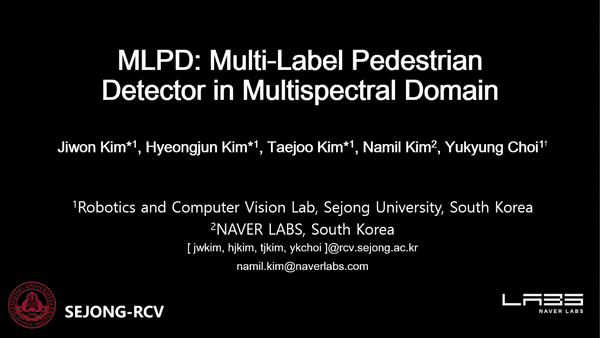Multispectral pedestrian detection has been actively studied as a promising multi-modality solution to handle illumination and weather changes. Most multi-modality approaches carry the assumption that all inputs are fully-overlapped. However, these kinds of data pairs are not common in practical applications due to the complexity of the existing sensor configuration. In this paper, we tackle multispectral pedestrian detection, where all input data are not paired. To this end, we propose a novel single-stage detection framework that leverages multi-label learning to learn input state-aware features by assigning a separate label according to the given state of the input image pair. We also present a novel augmentation strategy by applying geometric transformations to synthesize the unpaired multispectral images. In extensive experiments, we demonstrate the efficacy of the proposed method under various real-world conditions, such as fully-overlapped images and partially-overlapped images, in stereo-vision.
| Methods | Backbone | All | Day | Night |
|---|---|---|---|---|
| ACF | - | 47.32 | 42.57 | 56.17 |
| Halfway Fusion | VGG16 | 25.75 | 24.88 | 26.59 |
| Fusion RPN+BF | VGG16 | 18.29 | 19.57 | 16.27 |
| IAF R-CNN | VGG16 | 15.73 | 14.55 | 18.26 |
| IATDNN+IASS | VGG16 | 14.95 | 14.67 | 15.72 |
| CIAN | VGG16 | 14.12 | 14.77 | 11.13 |
| MSDS-RCNN | VGG16 | 11.34 | 10.53 | 12.94 |
| AR-CNN | VGG16 | 9.34 | 9.94 | 8.38 |
| MBNet | ResNet50 | 8.13 | 8.28 | 7.86 |
| MLPD (Ours) | VGG16 | 7.58 | 7.95 | 6.95 |
| MLPD (Ours) | ResNet50 | 7.61 | 8.36 | 6.35 |
- Ubuntu 18.04
- Python 3.7
- Pytorch 1.6.0
- Torchvision 0.7.0
- CUDA 10.1
- docker/requirements.txt
git clone https://github.com/sejong-rcv/MLPD-Multi-Label-Pedestrian-Detection.git
cd MLPD-Multi-Label-Pedestrian-Detection
- Prerequisite
cd docker
make docker-make
cd ..
nvidia-docker run -it --name mlpd -v $PWD:/workspace -p 8888:8888 -e NVIDIA_VISIBLE_DEVICES=all --shm-size=8G mlpd /bin/bash
For multispectral pedestrian detection, we train and test the proposed model on the KAIST dataset, you should first download the dataset. By default, we assume the dataset is stored in data/kaist-rgbt. Please see more details below.
We train the proposed model with paired annotations(annotations_paired) provided by AR-CNN.
Download and place them in the directory data/kaist-rgbt/.
<DATA_PATH>
+-- doc
+-- docker
+-- src
| +-- kaist_annotations_test20.json
| +-- imageSets
| | +-- train-all-02.txt
| | +-- test-all-20.txt
+-- data
| +-- kaist-rgbt
| | +-- annotations_paired
| | | +-- set00
| | | | +-- V000
| | | | | +-- lwir
| | | | | | +-- I00000.txt
| | | | | +-- visible
| | | | | | +-- I00000.txt
| | +-- images
| | | +-- set00
| | | | +-- V000
| | | | | +-- lwir
| | | | | | +-- I00000.jpg
| | | | | +-- visible
| | | | | | +-- I00000.jpg
If you want to change default parameters, you can modify them in the module src/config.py.
Please, refer to the following code to train and evaluate the proposed model.
cd src
python train_eval.py
If you want to adjust the number of GPUs, add 'CUDA_VISIBLE_DEVICES'
(optional) e.g. CUDA_VISIBLE_DEVICES=0,1 python train_eval.py
If you want to skip the training process, download the pre-trained model and place it in the directory pretrained/.
Or just run below command
$ ./script/download_pretrained_model.shTry below command to get inference from pretrained model
$ cd src
$ python inference.py --FDZ original --model-path ../pretrained/best_checkpoint.pth.tar++ If you want to visualize the results, try addding the --vis argument. Like below
$ python inference.py --FDZ original --model-path ../pretrained/best_checkpoint.pth.tar --visVisualization results are stored in 'result/vis'.
If you want to check the results of the 'FDZ' experiments, you can run the file
$ sh FDZ_exp.shYou can evaluate the result files of the models with the evaluation script below and draw all the results of state-of-the-art methods in a single figure to make it easy to compare.
The figure represents the miss-rate against false positives per image. Please refer to the paper for more understanding of the metric and figure.
Annotation files only support a json format. For results files, json and txt formats are supported.
(multiple --rstFiles are supported)
cd ..
cd evaluation_script
$ python evaluation_script.py \
--annFile KAIST_annotation.json \
--rstFile state_of_arts/MLPD_result.txt \
state_of_arts/ARCNN_result.txt \
state_of_arts/CIAN_result.txt \
state_of_arts/MSDS-RCNN_result.txt \
state_of_arts/MBNet_result.txt \
--evalFig figure.jpg
We appreciate the provider of SSD code a-PyTorch-Tutorial-to-Object-Detection and Soonmin Hwang who contributed to the SSD-like Halfway architecture. This code is built mostly based on them.
@INPROCEEDINGS{ IEEE RA-L with IROS2021
author = {JIWON KIM*, HYEONGJUN KIM*, TAEJOO KIM*, NAMIL KIM, AND YUKYUNG CHOI†},
title = {MLPD: Multi-Label Pedestrian Detector in Multispectral Domain},
booktitle = {IEEE Robotics and Automation Letters (RA-L)},
year = {2021}
}




